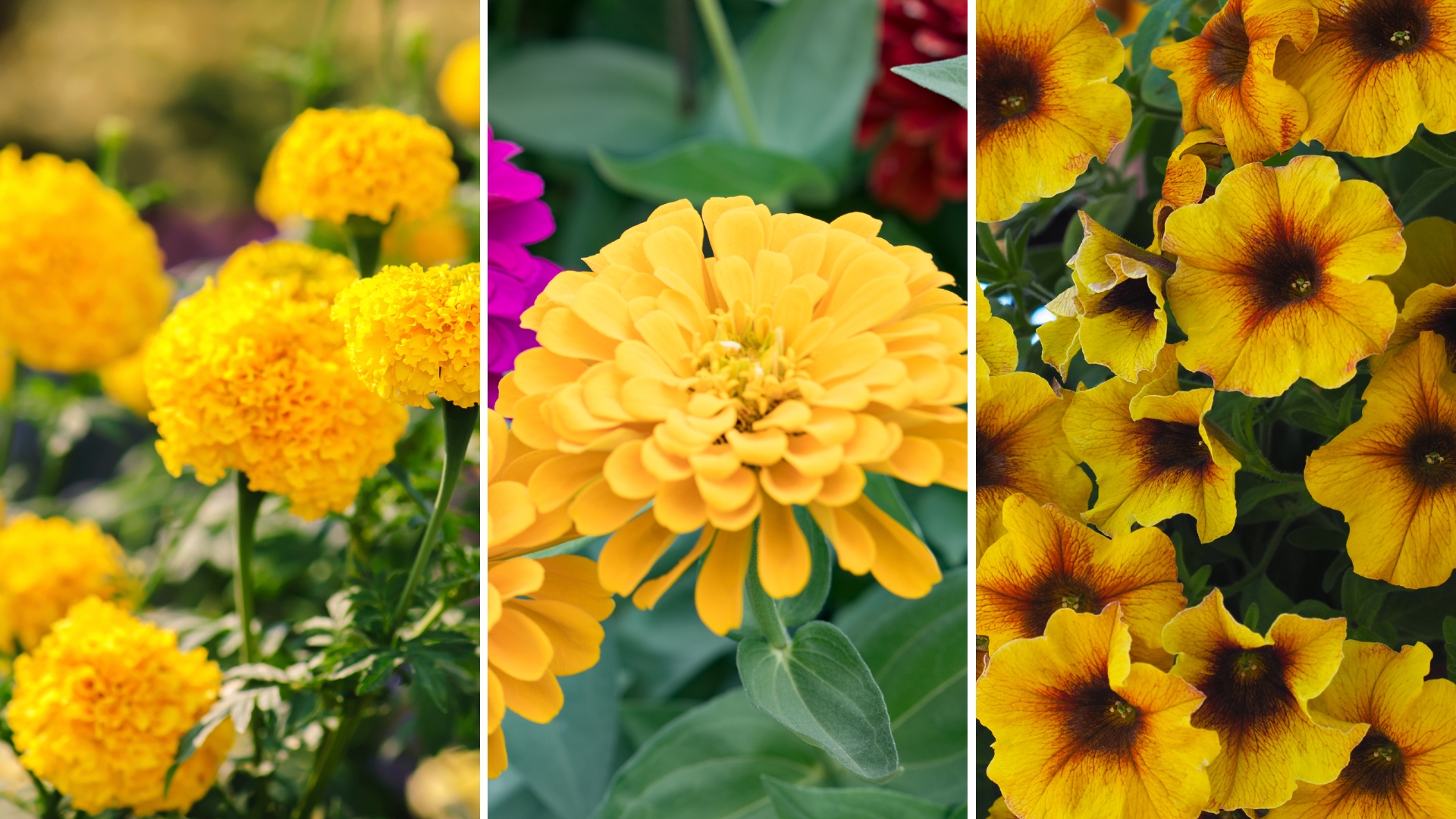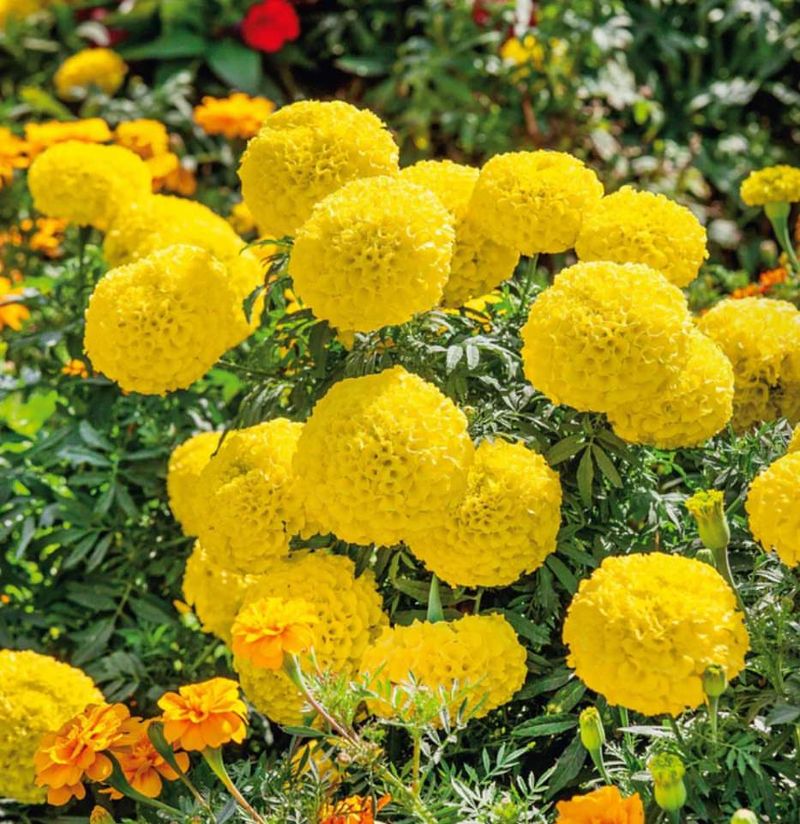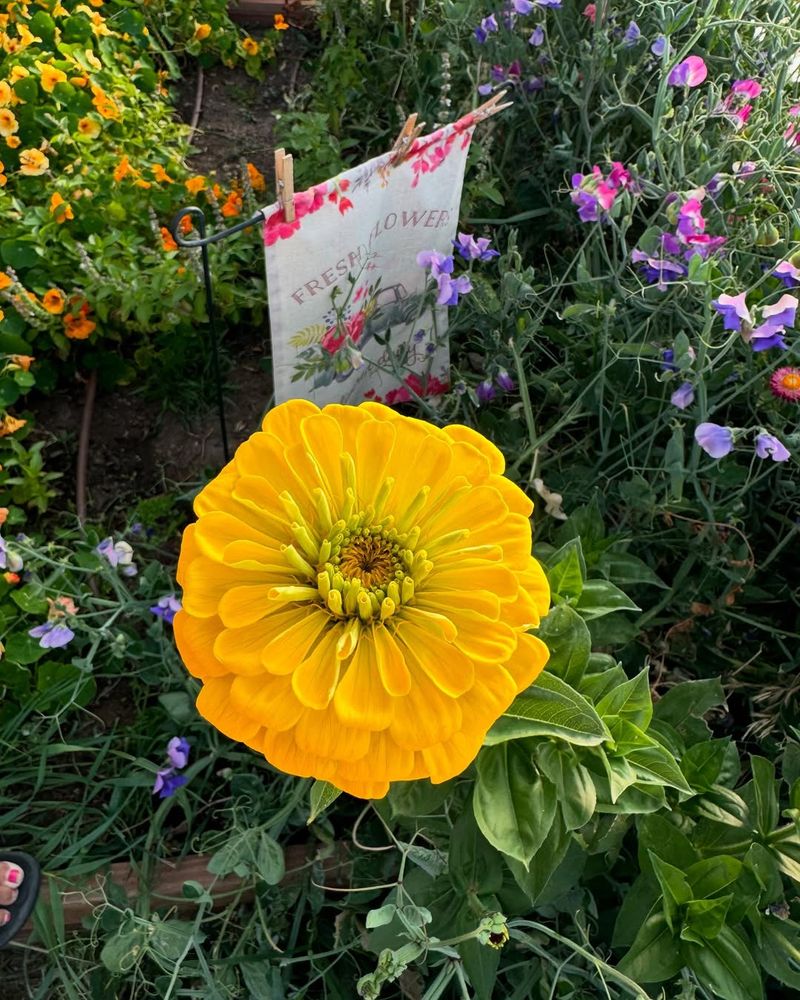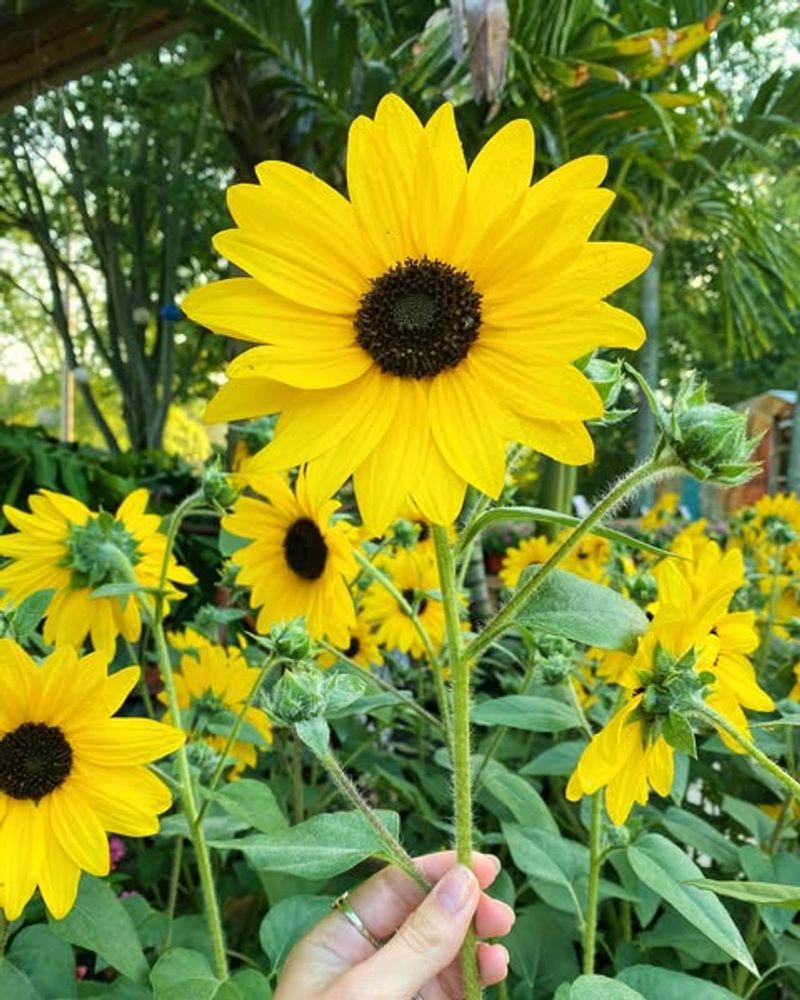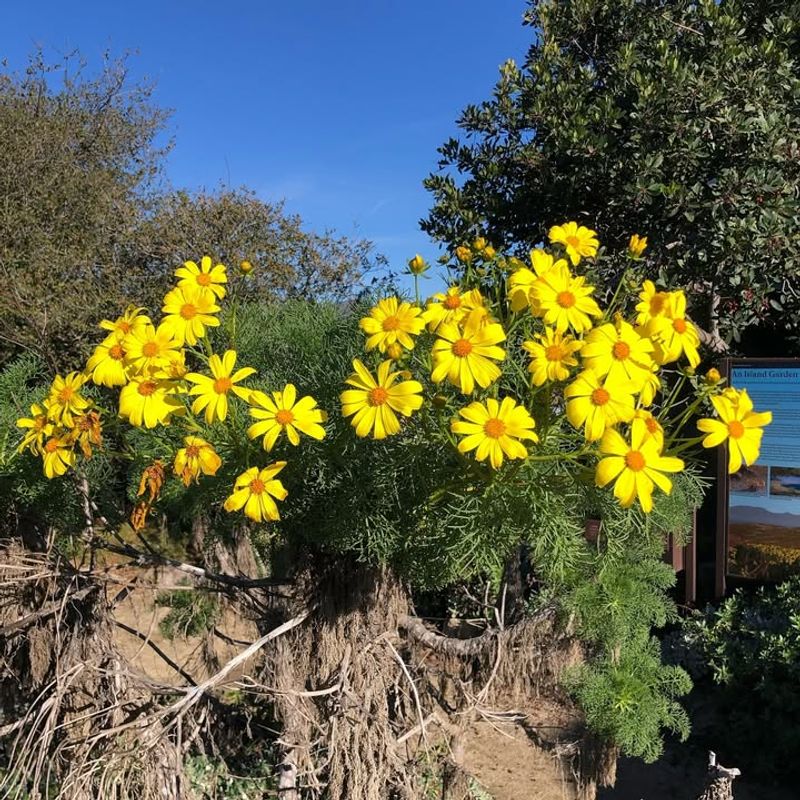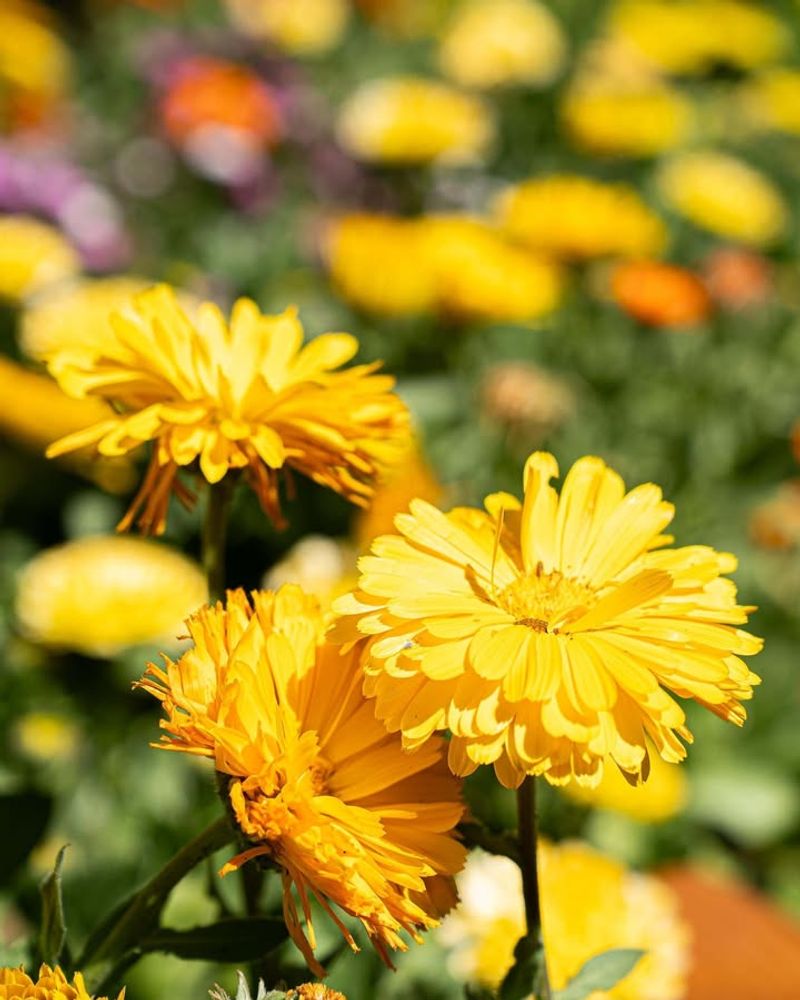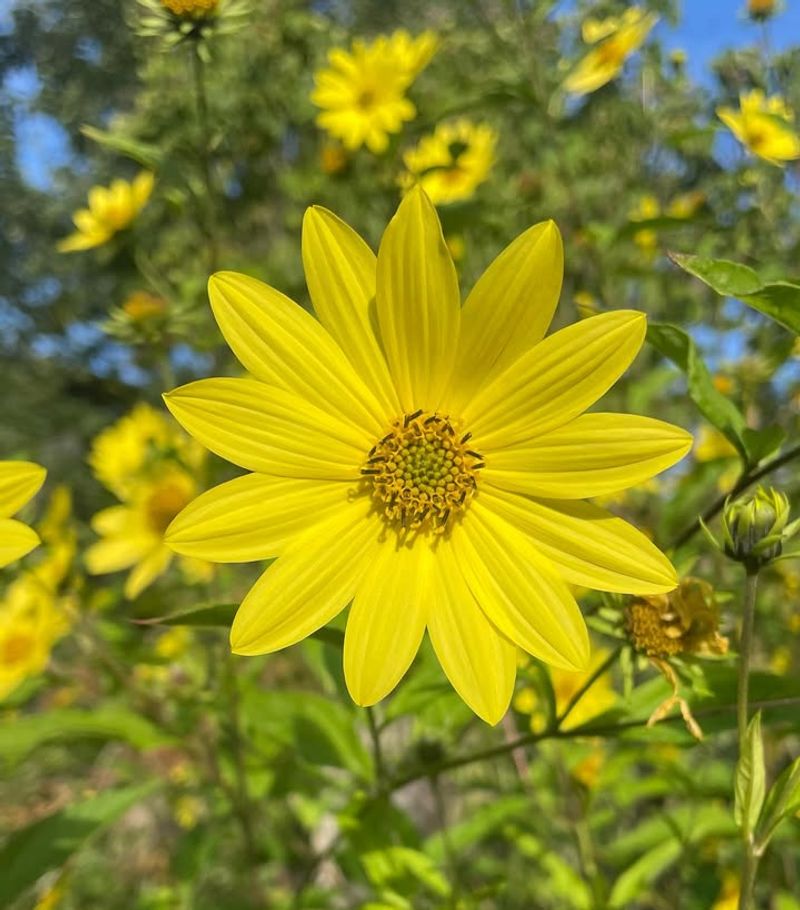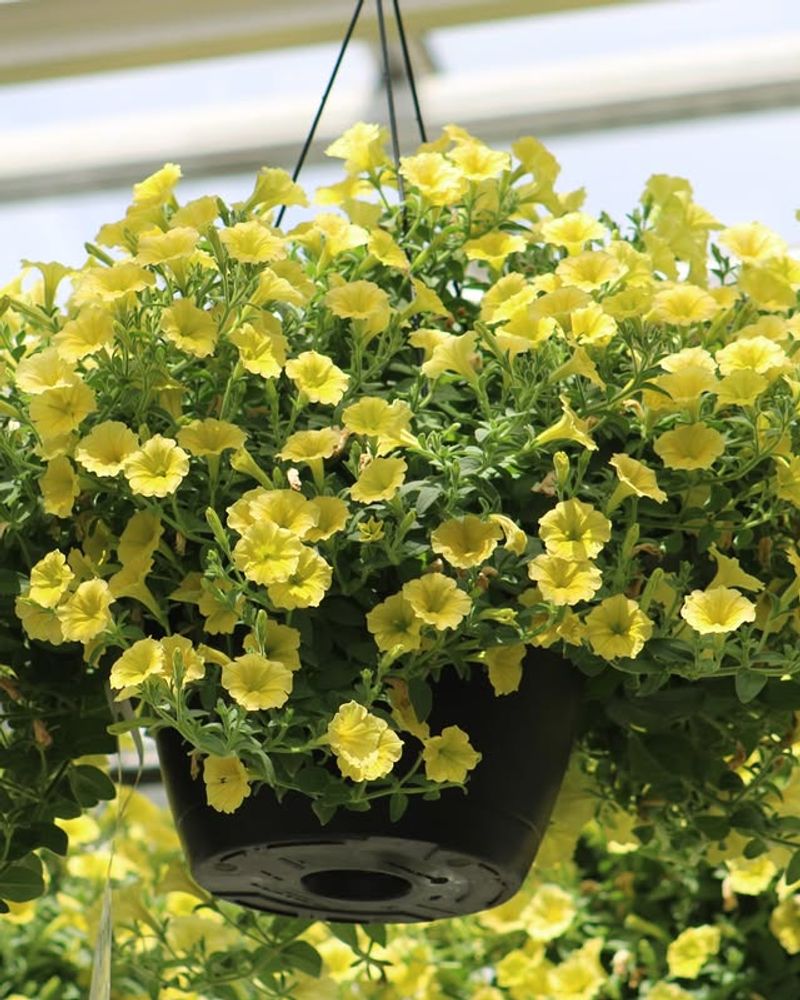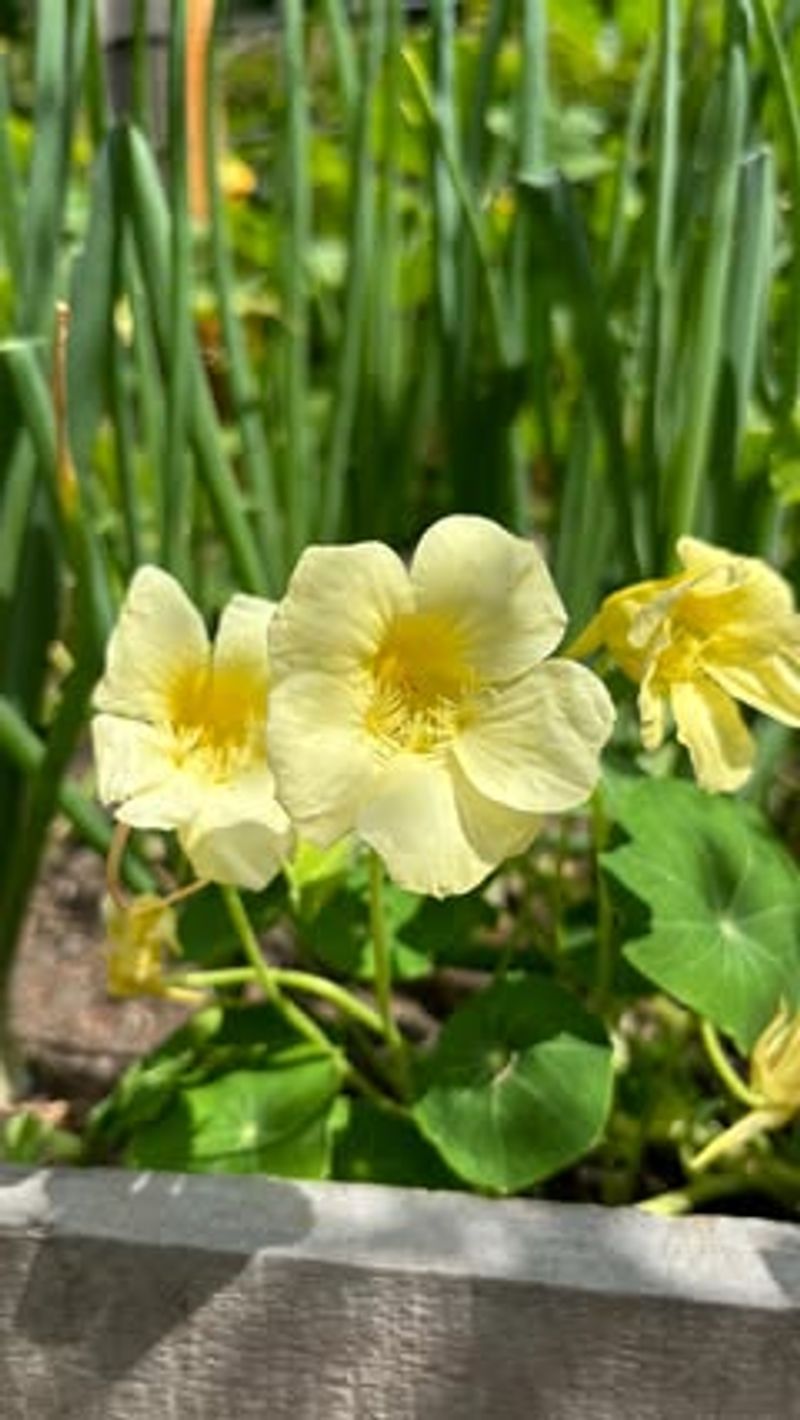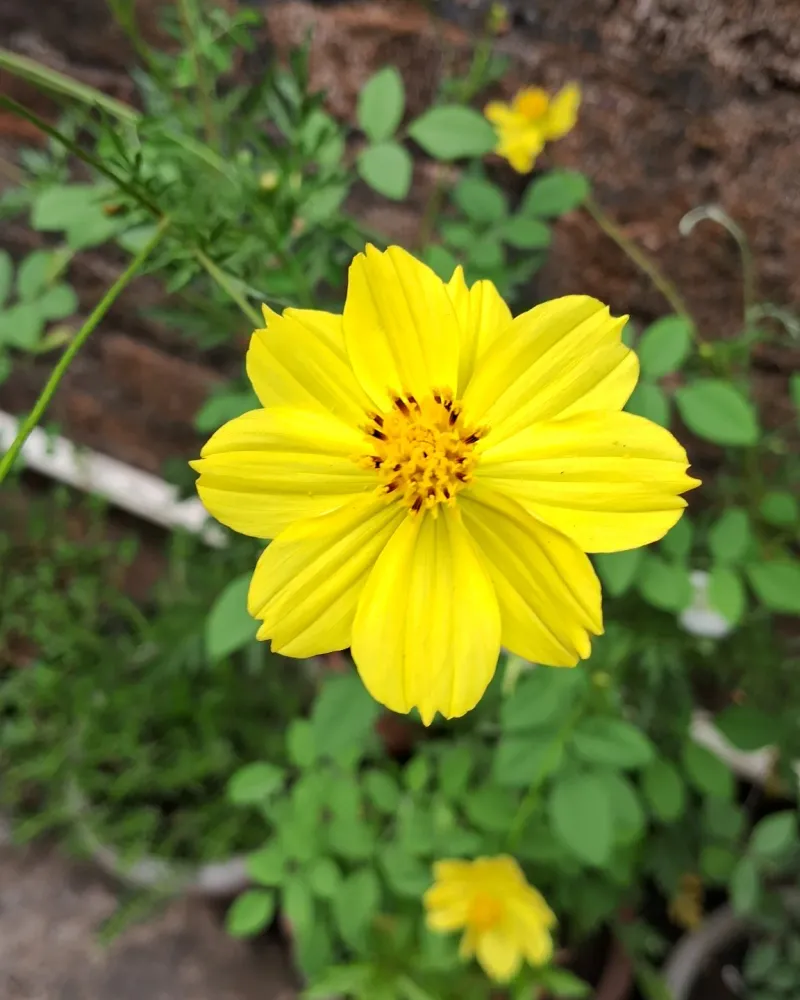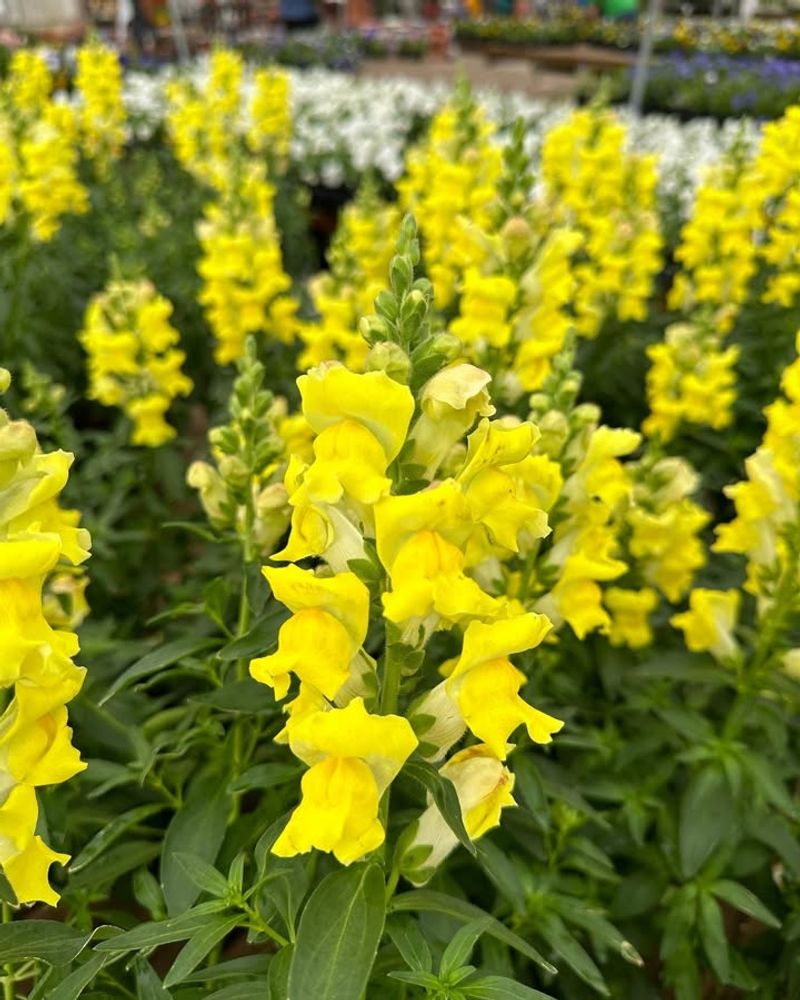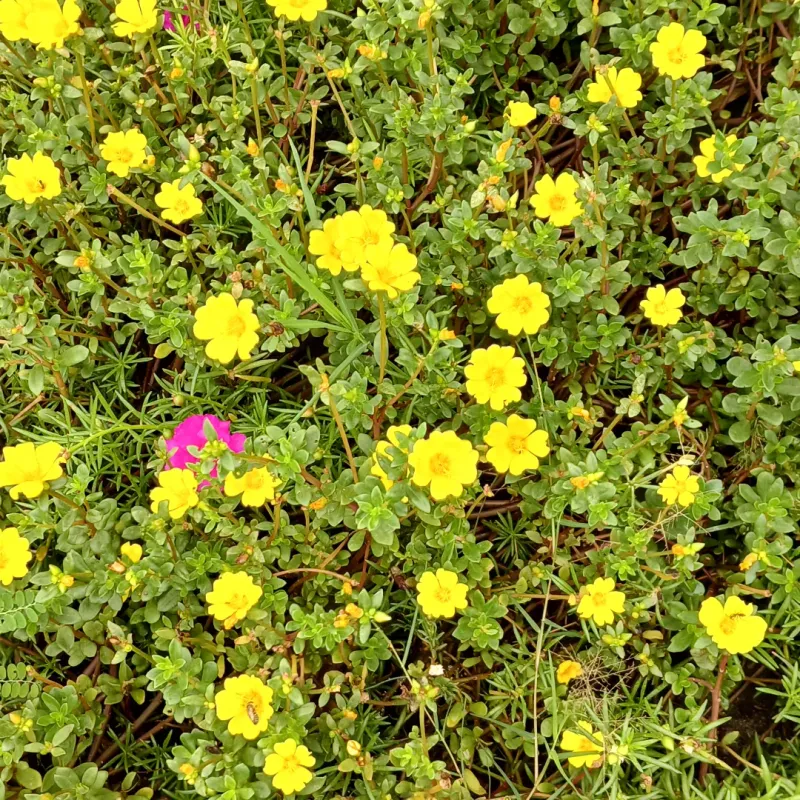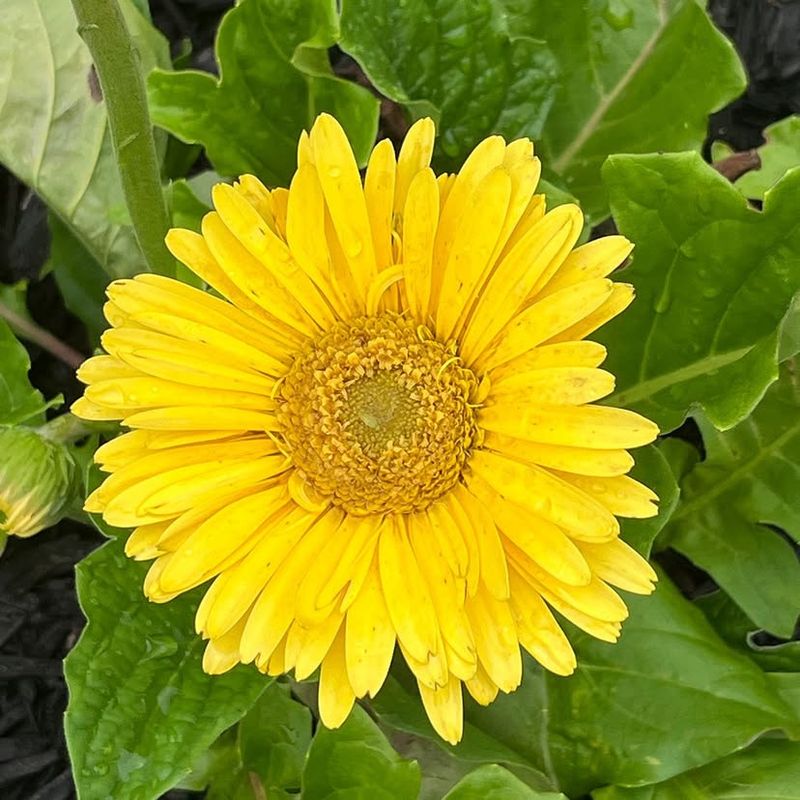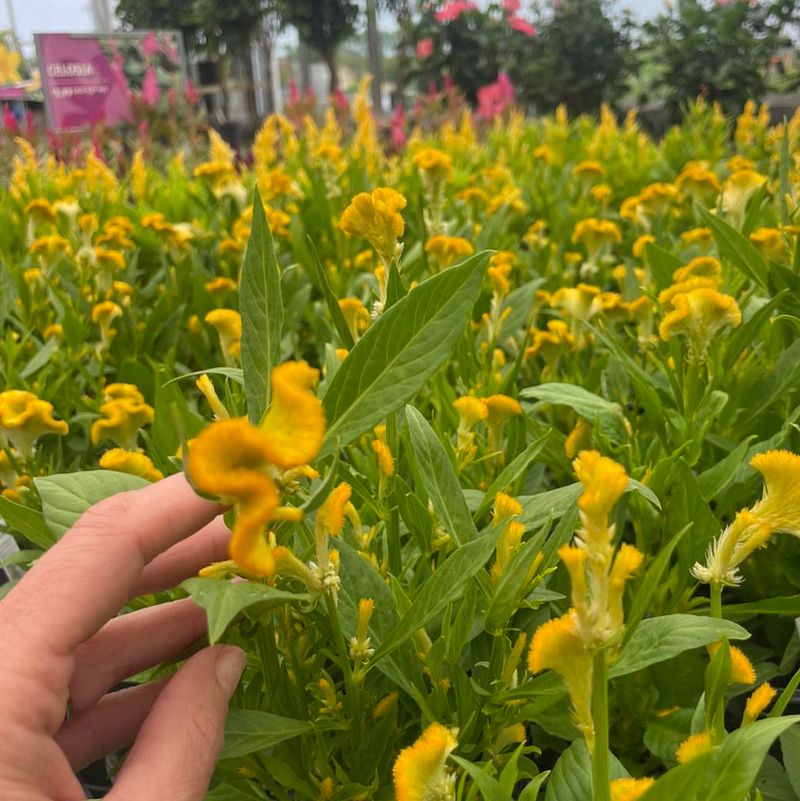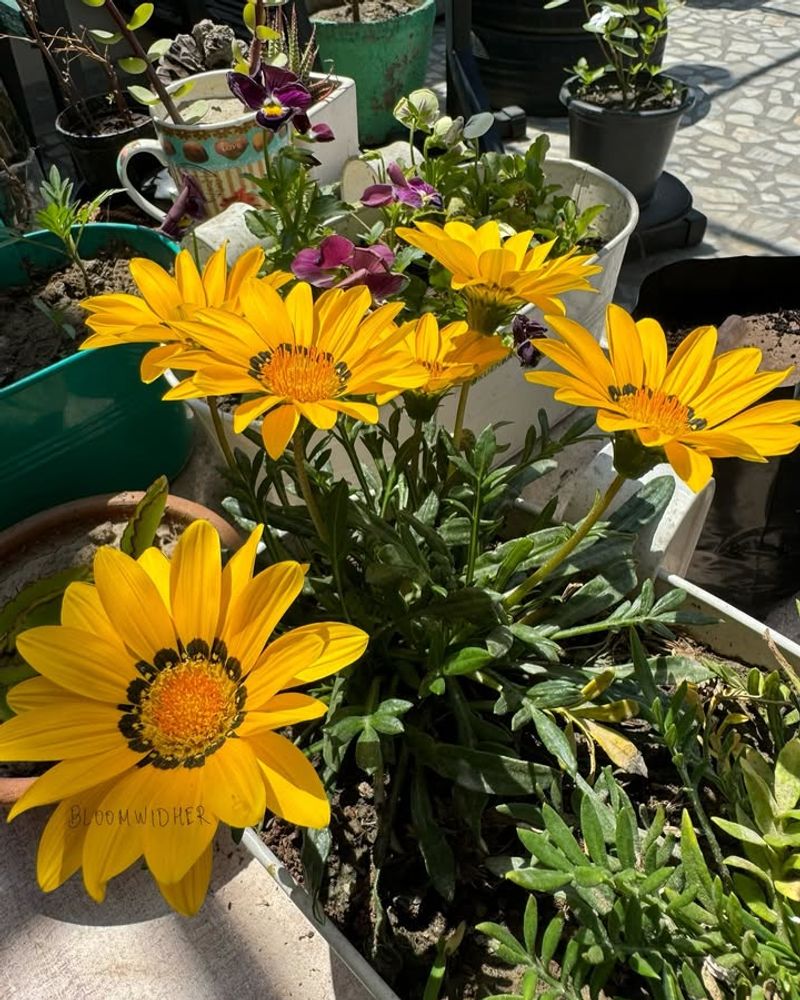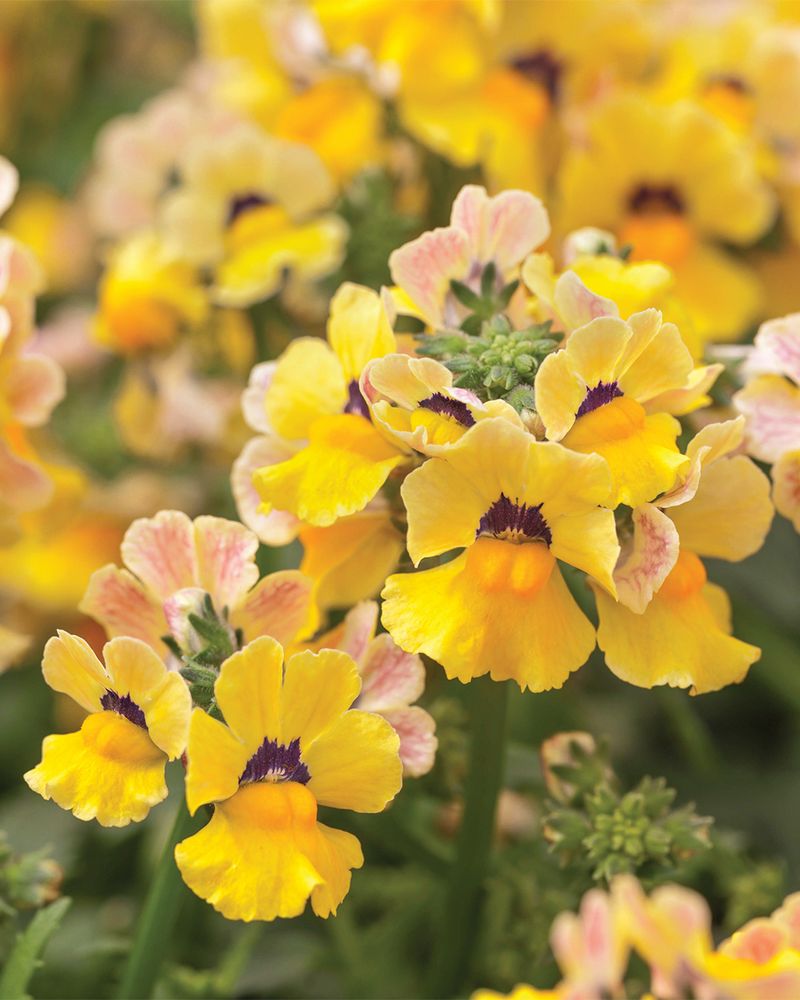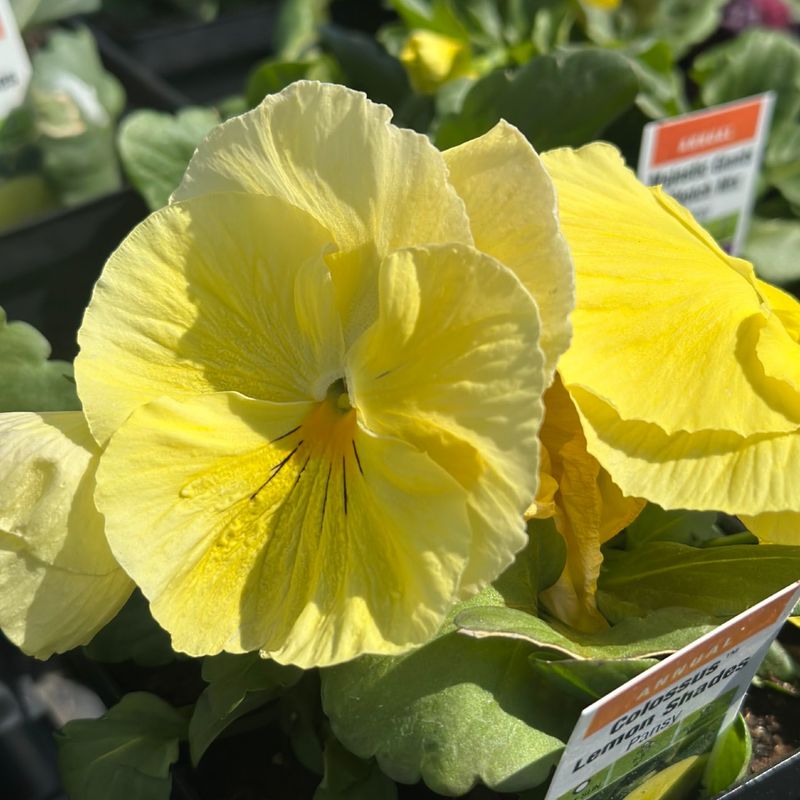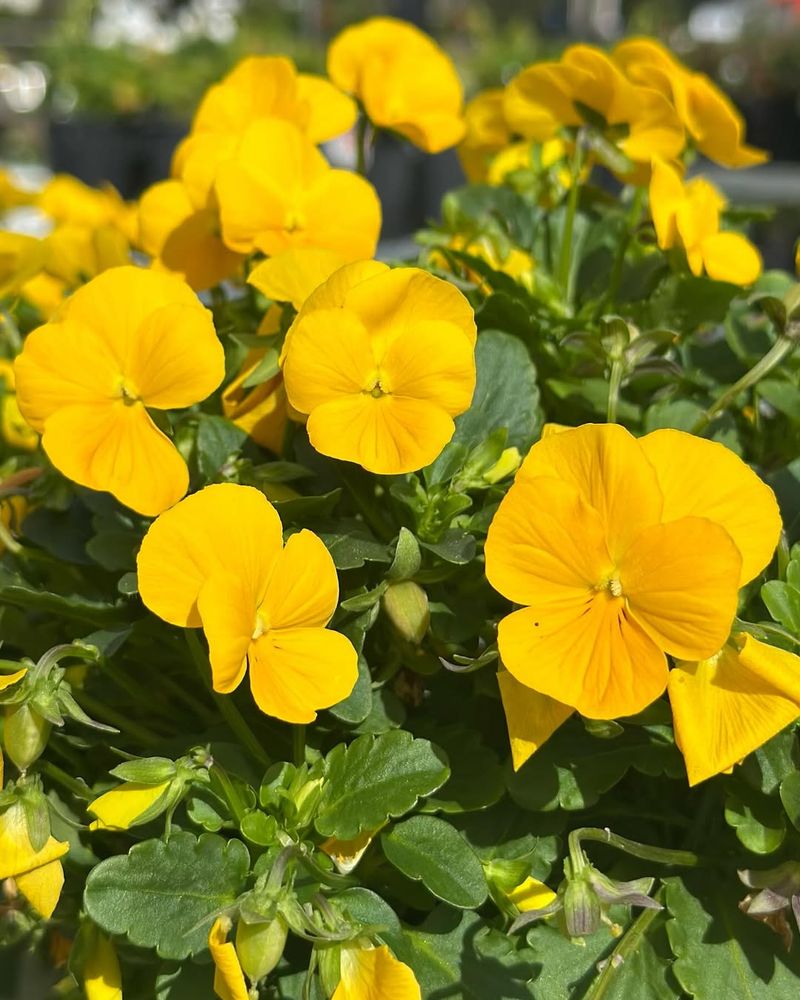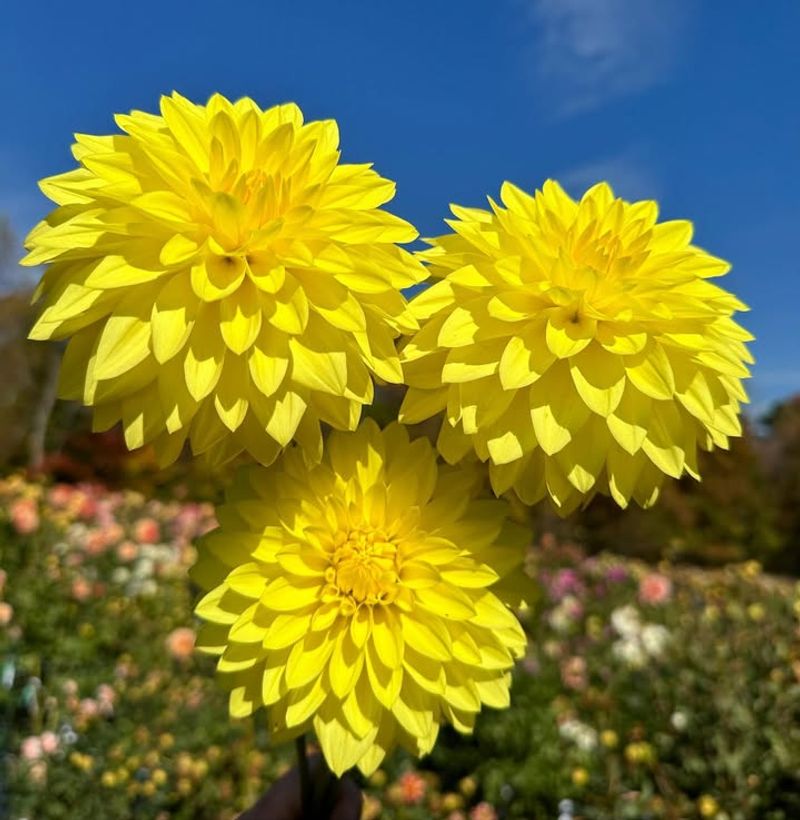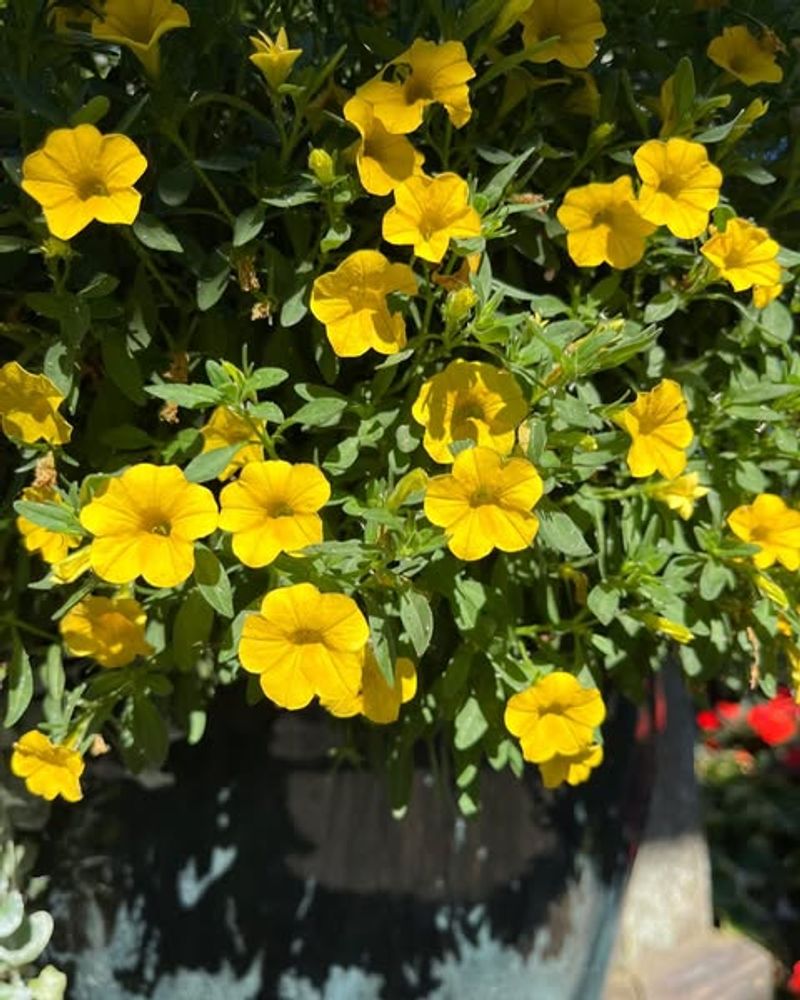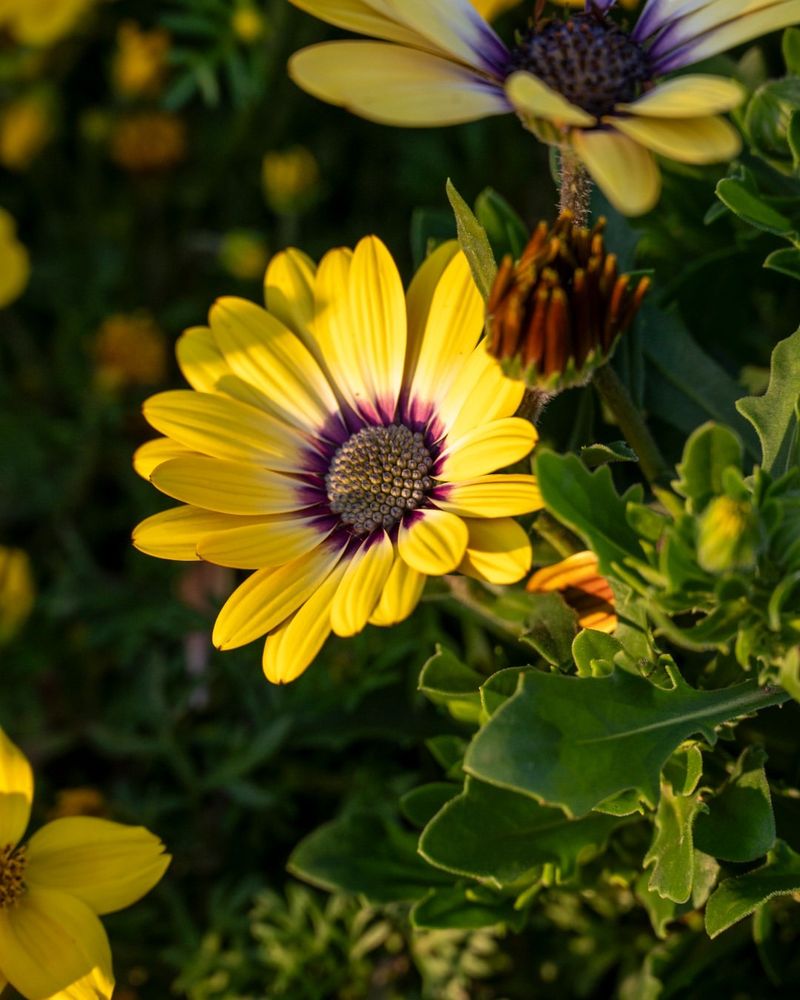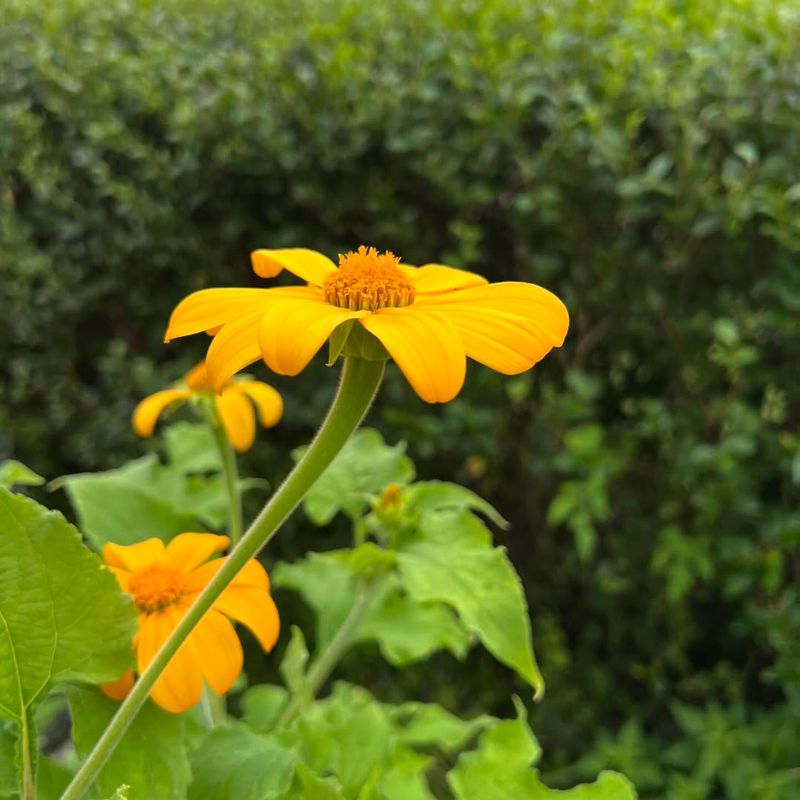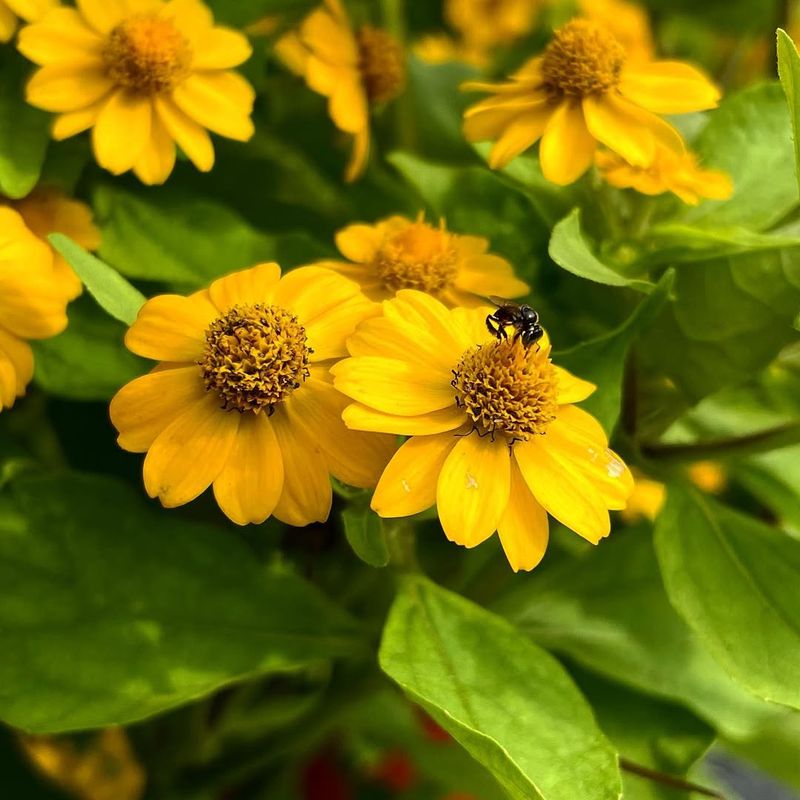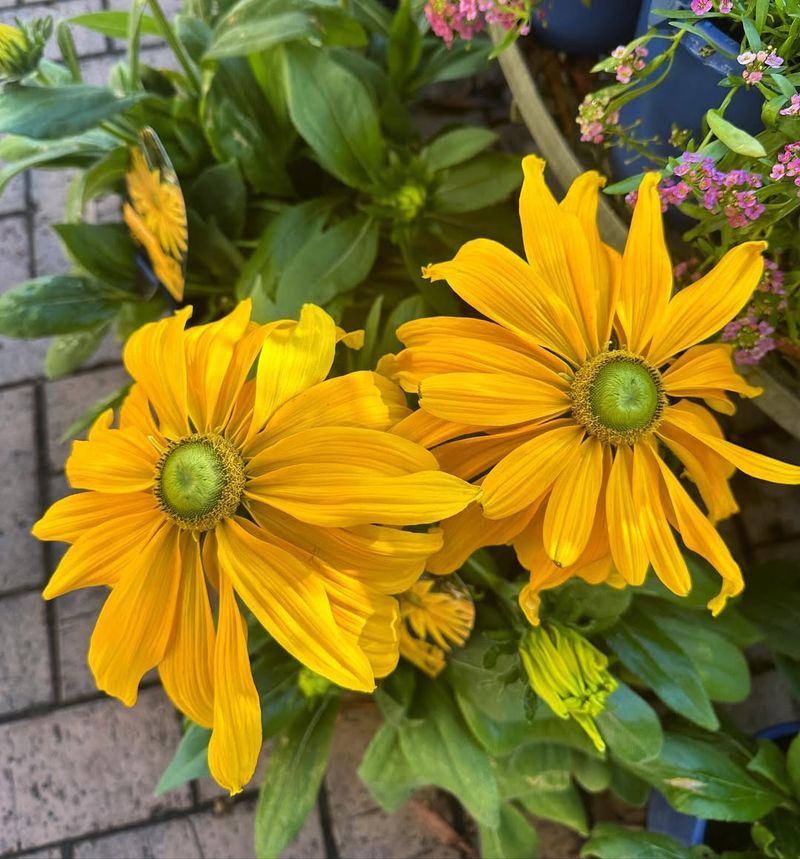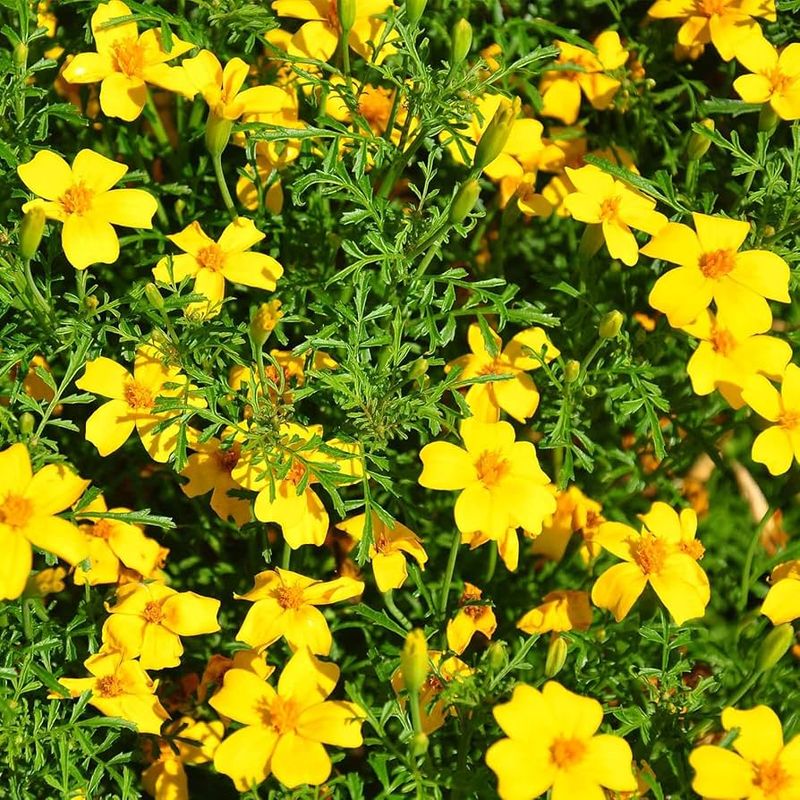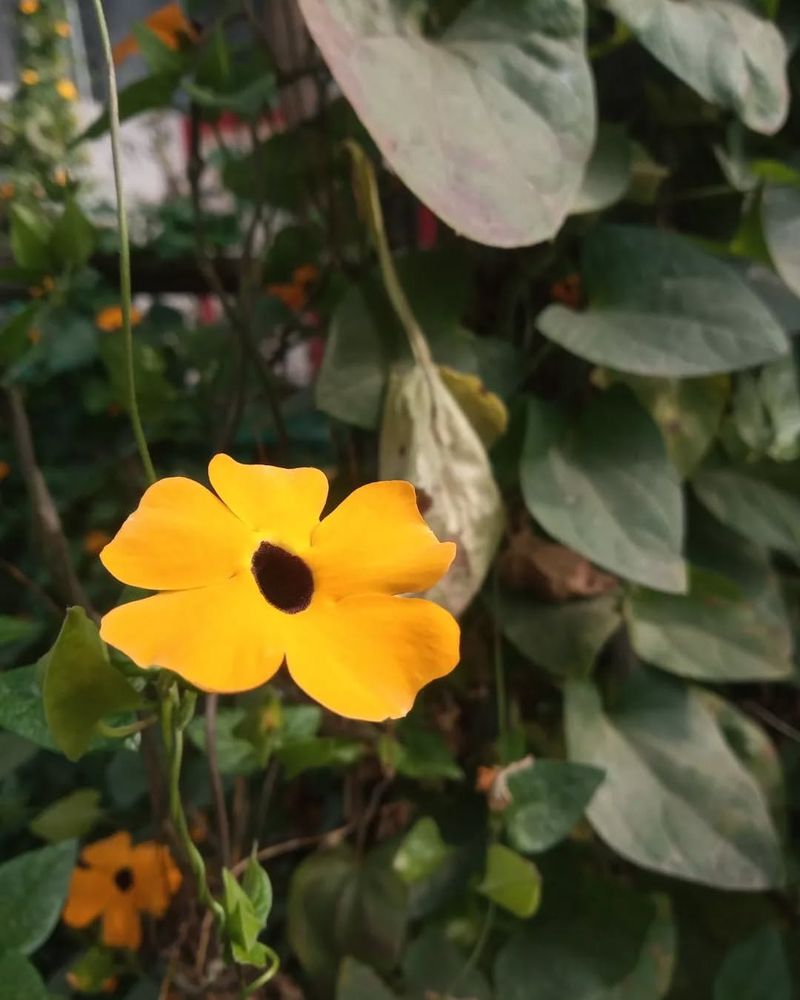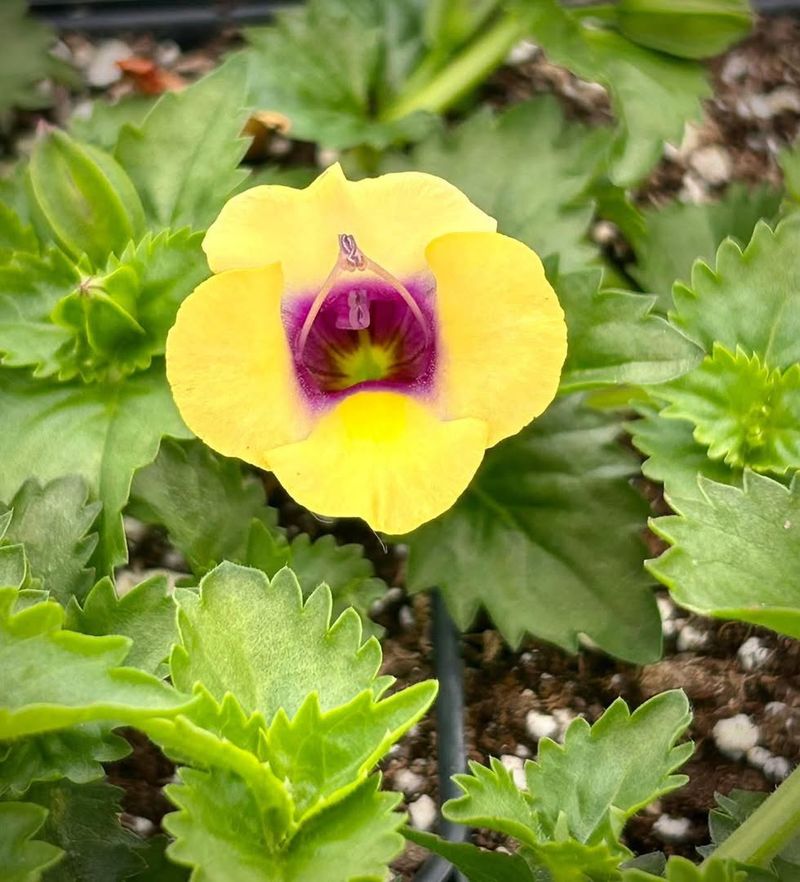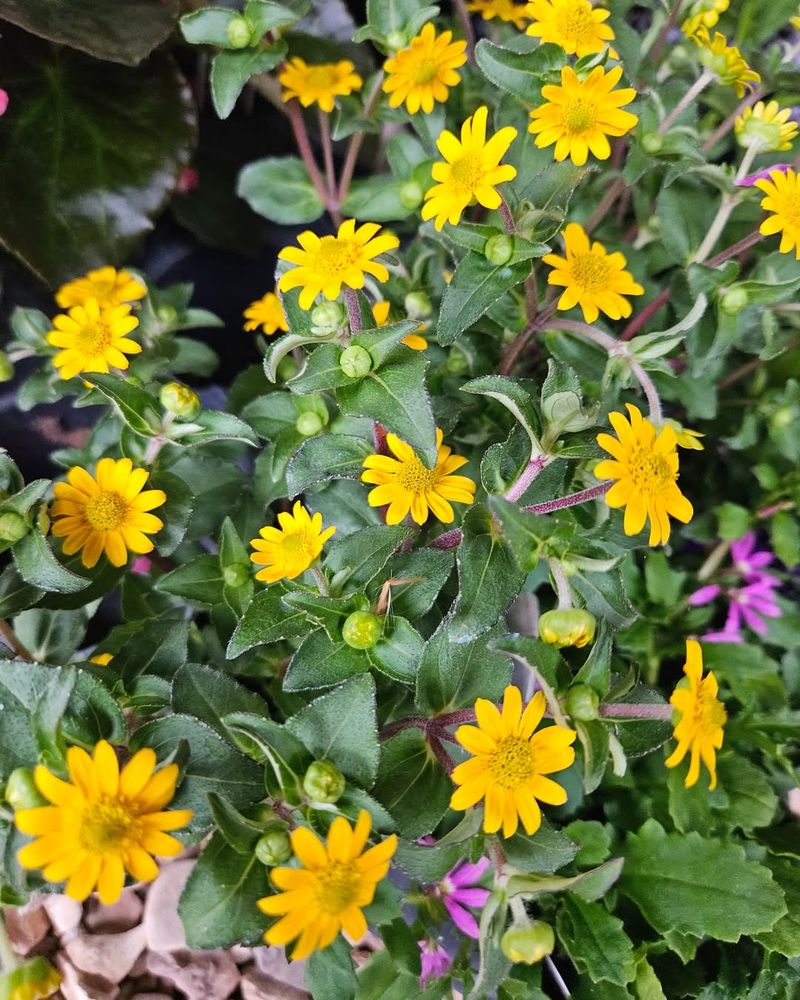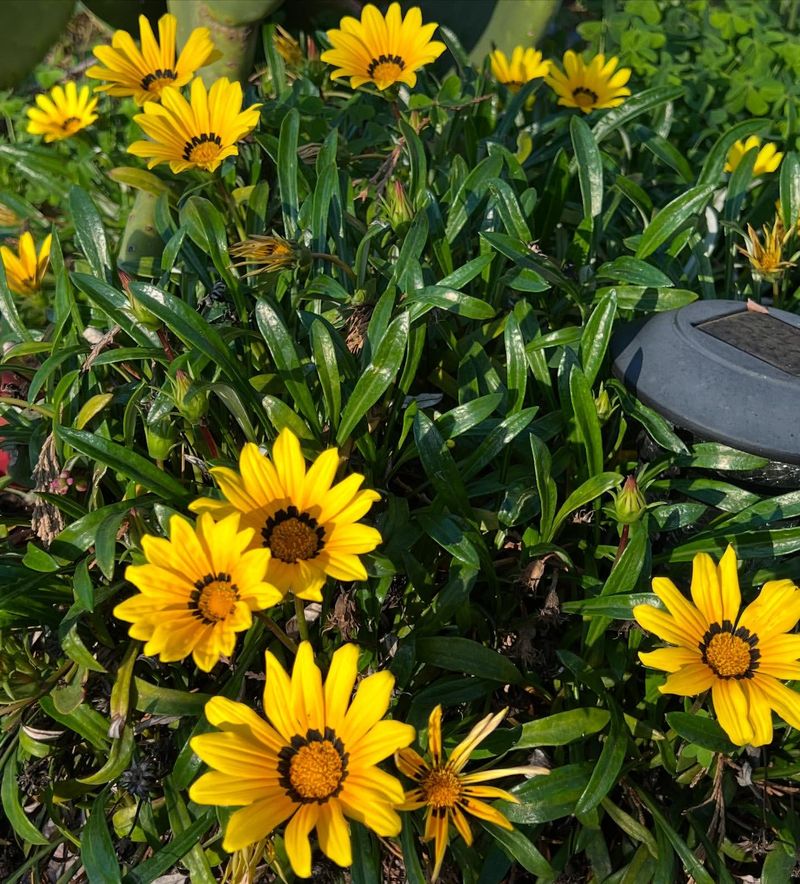Yellow annuals can transform your garden into a vibrant, sun-kissed paradise. Their cheerful color adds a burst of warmth and brightness, making any outdoor space feel more inviting. Whether you’re a seasoned gardener or a novice, there’s a yellow-blooming annual perfect for your garden. From the sunny faces of marigolds to the striking plumes of celosia, each plant offers a unique charm and beauty. Join me as we explore 30 of the best yellow-flowering annuals that promise to bring joy and a splash of color to your garden all season long.
1. Marigold
Marigolds are cheerful classics, blooming in bright golden yellows that bring instant warmth to any garden. Their ruffled petals and bold color light up borders, beds, and containers alike.
These sun-lovers thrive in well-drained soil and full light, requiring minimal effort for a big reward. Water regularly and deadhead spent blooms to keep the color coming.
Plant marigolds around vegetable gardens to help deter pests or line your pathways for a sunny welcome. Their vibrant blooms are both hardworking and eye-catching—truly a garden staple.
2. Zinnia (Yellow varieties)
Yellow zinnias are radiant and resilient, boasting tall stems topped with bold, daisy-like blooms that last for weeks. Their bright, sunny tones scream summer happiness.
Plant them in full sun with well-drained soil, and they’ll reward you with nonstop color from late spring through fall. Zinnias love the heat and tolerate dry spells with ease.
Tuck them into cutting gardens or mass plant them in sunny beds for an energetic, wildflower-style effect. Bonus: butterflies absolutely adore them!
3. Sunflower (Annual varieties)
Few flowers say “summer” like the towering, golden face of a sunflower. Annual varieties range from compact to tall, but all offer that unmistakable sunbeam charm.
They grow best in full sun with well-draining soil and love to follow the light throughout the day. Water them regularly, especially during dry spells, and they’ll shoot up in no time.
Use dwarf sunflowers in containers or along fences, or go bold with tall varieties in the back of borders. Their bright blooms double as pollinator magnets and statement makers.
4. Coreopsis (Annual types)
Coreopsis adds a splash of sunshine to the garden with its daisy-like yellow flowers that dance in the breeze. It feels both wild and refined—perfect for that casual cottage vibe.
It thrives in full sun and doesn’t mind poor soil or a bit of drought. Deadheading keeps it blooming strong all season.
Use coreopsis in wildflower meadows, sunny borders, or bee-friendly gardens where its carefree blooms can thrive. It pairs beautifully with blue salvia or purple coneflowers.
5. Calendula
Calendula glows with golden to buttery-yellow petals that look like little rays of sunshine. Its blooms are not only pretty—they’re edible and medicinal too!
It prefers cooler summer temperatures, full sun to part shade, and rich, well-drained soil. Keep soil moist and remove faded flowers to prolong blooming.
Perfect for raised beds, herb gardens, or edible landscapes, calendula is both lovely and useful. Sprinkle the petals in salads or dry them for homemade balms and teas.
6. Bidens
Bidens bursts with tiny, golden yellow star-shaped blooms that cover its lush, trailing foliage. It’s like confetti for your containers—vibrant, playful, and nonstop.
It thrives in full sun and well-drained soil, blooming heavily with minimal upkeep. Just water regularly and trim it back if it starts to sprawl too far.
Use bidens in hanging baskets, window boxes, or as a spiller in mixed pots. Its sunny color makes it an instant mood booster and pairs perfectly with purples or deep reds.
7. Petunia (Yellow varieties)
Yellow petunias are bright and buttery, bringing soft warmth and a romantic glow to your summer displays. Their trumpet-shaped blooms are both elegant and prolific.
They grow best in full sun and well-drained soil, with regular watering and deadheading to encourage constant blooms. Fertilizer helps keep the color going strong.
Plant them in baskets, patio planters, or bed borders where you want a soft, sunny accent. They mix beautifully with blue lobelia or white alyssum for a sweet summer look.
8. Nasturtium (Yellow varieties)
Nasturtiums are vibrant and edible, with cheerful yellow blooms and lily pad-like leaves that bring a whimsical vibe to any garden. They have a peppery kick that’s great in salads too!
They thrive in poor soil and full sun and don’t like to be overfed—less is more for blooms. Let them trail, climb, or sprawl depending on the variety.
Use nasturtiums in veggie beds, balcony boxes, or edible borders for color and function. They’re beautiful and tasty—what more could you ask for?
9. Cosmos (Yellow varieties)
Yellow cosmos offer dainty, daisy-like flowers on airy stems that flutter with every breeze. Their soft form adds a relaxed, wildflower look to garden spaces.
They grow well in poor soil and full sun, thriving with minimal effort. Deadheading helps them bloom nonstop until frost.
Plant cosmos in pollinator gardens, wildflower patches, or anywhere you want a burst of laid-back beauty. They also make graceful cut flowers for casual arrangements.
10. Snapdragon (Yellow selections)
Yellow snapdragons add a burst of sunshine and playful texture with their tall spikes and dragon-like blooms. They’re a classic with a twist when grown in bright, golden hues.
They prefer full sun to partial shade and thrive in rich, well-drained soil—especially in cooler parts of summer. Regular deadheading keeps the bloom spikes coming.
Use yellow snapdragons to add vertical interest to beds or brighten up spring and fall containers. Their unique shape and soft scent make them a favorite for kids and pollinators alike.
11. Lantana (Yellow varieties)
Yellow lantana blooms in bold clusters that shine in hot, dry conditions. Its flowers often shift shades, adding depth and variation to a single plant.
Plant it in full sun and average, well-drained soil—it doesn’t mind heat, humidity, or even a bit of neglect. Once it settles in, it’s tough as nails.
Lantana is perfect for drought-prone spots, curbside plantings, or sunny containers. Its blooms attract butterflies and add serious summer firepower to your garden.
12. Portulaca (Moss Rose – Yellow varieties)
Portulaca is a bright, low-growing bloomer with thick succulent leaves and wide-open yellow blooms that love the sun. It’s a heat-lover through and through.
It thrives in sandy, poor soil and requires very little water once established. Perfect for those dry, tricky spots.
Use portulaca in rock gardens, between stepping stones, or trailing from hot, sunny containers. Its blooms close at night and open each morning with the sun—a sweet daily surprise.
13. Gerbera Daisy (Yellow cultivars)
Yellow gerbera daisies are vibrant and showy, with large, perfectly round blooms that radiate happiness. They’re like a sunflower’s flirty little cousin.
Plant them in full sun and rich, well-drained soil, and keep them moist but not soggy. Deadheading helps encourage fresh blooms.
Use gerberas in patio pots, cutting gardens, or gift-worthy containers. Their long stems and cheerful faces make them a florist favorite for good reason.
14. Celosia (Yellow plumes)
Celosia’s yellow plumes stand tall like bursts of flame or soft feathers, bringing height and bold texture to garden beds. It’s both exotic and easygoing.
Grow celosia in full sun with well-drained soil, and watch it thrive through the summer heat. It’s drought-tolerant and low maintenance.
Use yellow celosia as a dramatic border accent or as part of a bold, tropical container mix. It also dries beautifully for everlasting bouquets or crafts.
15. Gazania (Yellow selections)
Gazania brings a burst of bright, bold yellow with daisy-like blooms that practically sparkle in the sun. Its petals often feature striking stripes or bicolor details that make each bloom pop.
It thrives in full sun and dry, well-drained soil—heat and drought don’t faze it one bit. Close the blooms at night, and open with the morning light like clockwork.
Use gazania in rock gardens, containers, or curbside beds where resilience meets beauty. It’s the perfect pick for low-maintenance color that keeps shining through the heat.
16. Nemesia (Yellow types)
Nemesia’s soft yellow blooms are like little bursts of sunshine with a sweet, citrusy scent. These dainty flowers grow in cheerful clusters that light up borders and pots.
They thrive in cool temperatures with full to part sun and moist, well-drained soil. Regular deadheading will keep the blooms coming longer.
Use yellow nemesia in early-season containers, edging for spring beds, or tucked into window boxes. They’re perfect for adding a soft, scented glow to smaller spaces.
17. Pansy (Yellow shades)
Yellow pansies bring a cheerful, friendly face to the garden with their bold petals and expressive markings. They’re especially stunning in cooler climates where their color shines the longest.
They love full sun to part shade and rich, moist soil. Deadhead often to keep the blooms fresh and full.
Try yellow pansies in window boxes, front porch containers, or early spring beds. Their bright tones make a great match with purples or blues for a high-contrast look.
18. Viola (Yellow selections)
Violas are petite but powerful, offering sunny blooms that are as sweet in scent as they are in appearance. Their soft petals often feature delicate shading and subtle patterns.
They prefer cooler weather, part sun, and consistently moist, well-drained soil. Deadhead regularly to enjoy blooms that go on and on.
Use yellow violas as edging, in fairy gardens, or scattered through spring and fall containers. Their charming look and soft fragrance make them irresistible up close.
19. Dahlia (Annual yellow types)
Yellow dahlias are absolute showstoppers, with intricate, layered blooms that range from soft buttercream to golden rays. Each flower feels like a little masterpiece.
They love full sun, rich soil, and consistent moisture. Taller varieties may need staking to keep their heavy blooms upright.
Plant yellow dahlias in cutting gardens, formal borders, or patio planters for non-stop drama. They look especially elegant mixed with deep purples or dark greens.
20. Impatiens (Yellow cultivars)
Yellow impatiens are rare and eye-catching, adding a glowing pop to shady garden spots. Their soft petals and compact habit make them ideal for containers or underplanting.
They prefer full to partial shade and moist, well-draining soil. Keep them watered and fed regularly to maintain lush growth.
Use yellow impatiens to brighten dim corners or mix with deeper-colored blooms for contrast. Their gentle color adds a fresh, unexpected twist to classic shade plantings.
21. Calibrachoa (Yellow varieties)
Calibrachoa, also known as “million bells,” spills over containers with hundreds of mini petunia-like blooms in glowing yellow. It’s compact, cheerful, and blooms like it’s showing off.
Give it full sun, well-drained soil, and a steady watering schedule—it’ll thank you with nonstop color. A little fertilizer keeps the blooms vibrant and full.
Use yellow calibrachoa in hanging baskets, window boxes, or patio pots for a cascade of sunshine. It pairs perfectly with purple or coral flowers for a fun summer mix.
22. Osteospermum (Yellow selections)
Osteospermum, or African daisy, adds elegance with clean yellow petals and often striking centers. These daisy-shaped blooms are bold and tidy, with a modern edge.
They prefer full sun and cooler temps, doing best in spring and fall in warmer zones. Water regularly and remove spent blooms to keep the color going.
Use them in containers, along walkways, or in front-of-border plantings for neat, eye-catching color. Their graphic shape makes them great in monochrome designs or modern gardens.
23. Tithonia (Mexican Sunflower)
Tithonia blazes in golden-orange tones that verge on glowing, with blooms that attract butterflies in droves. Its tall stems and bold presence make it unforgettable.
Grow it in full sun and well-drained soil, and give it space—it can reach impressive heights. Once it starts blooming, it doesn’t hold back.
Plant Tithonia at the back of borders or in pollinator gardens where it can show off. It’s the perfect pick for gardeners who love wild energy and vibrant color.
24. Melampodium
Melampodium is a low-maintenance superstar, covered in cheerful yellow daisy-like flowers all summer long. It’s small, tidy, and tough as nails.
It thrives in full sun and poor soil, and once it’s established, it barely needs a thing. Just water occasionally and enjoy.
Use melampodium as a groundcover, edging plant, or filler in hot, sunny containers. It’s a great way to keep color going strong with almost no effort.
25. Rudbeckia hirta (Annual varieties)
Rudbeckia, or black-eyed Susan, brings big, bold blooms with golden petals and dark, dramatic centers. It’s summer’s signature flower and a true garden favorite.
It grows best in full sun and well-drained soil, blooming steadily through the heat. Deadheading helps extend the show.
Plant rudbeckia in beds, borders, or wildflower patches for a rustic, prairie-style look. It’s great for cut flowers and brings pollinators by the dozen.
26. Tagetes tenuifolia (Signet Marigold)
Signet marigolds are petite and dainty, with ferny foliage and a bounty of small, lemon-yellow blooms. Unlike their fuller cousins, they bring a light, airy feel to the garden.
They thrive in full sun and well-drained soil, handling heat and poor conditions with ease. Their edible flowers have a citrusy flavor—perfect for garnishes.
Use signet marigolds in herb gardens, raised beds, or as edible edging in veggie plots. Their delicate flowers add charm and a fresh pop of color to any sunny space.
27. Thunbergia alata (Yellow Black-Eyed Susan Vine)
This climbing vine produces cheerful, soft yellow blooms with dramatic dark centers that look like tiny eyes. It brings vertical color and a playful vibe to any garden structure.
It grows quickly in full sun to part shade with moist, well-drained soil. Provide a trellis or arch, and it’ll climb and bloom nonstop.
Plant thunbergia to dress up fences, pergolas, or balcony railings. Its bold flowers and lush foliage create a summery wall of sunshine wherever it grows.
28. Torenia (Yellow cultivars)
Yellow torenia, or wishbone flower, is a surprise burst of brightness in shady spaces. Its tubular blooms and compact shape make it a standout among low-light plants.
It prefers part to full shade and consistently moist, rich soil. It’s low-maintenance and blooms happily all summer long.
Use torenia in porch planters, shady beds, or as an underplanting around larger annuals. Its sunny color and soft texture bring life to shadowed corners.
29. Sanvitalia (Creeping Zinnia)
Sanvitalia may be tiny, but its impact is mighty. With small, golden blooms and a low, trailing habit, it’s like a mini sunflower that hugs the ground.
It thrives in full sun, tolerates drought, and keeps blooming even in tough spots. It’s perfect for hot, dry gardens.
Use sanvitalia in rock gardens, hanging baskets, or to edge containers with cheerful color. Its blooms keep going without fuss and create a sweet, sunny carpet.
30. African Daisy (Dimorphotheca – Yellow varieties)
African daisies offer bold yellow blooms with eye-catching, often dark centers and perfectly symmetrical petals. They’re clean, graphic, and radiate sunshine.
They grow best in full sun and dry, well-drained soil and are super heat- and drought-tolerant. Give them a little deadheading for longer bloom time.
Use African daisies in containers, xeriscapes, or modern garden beds where bold color and clean lines shine. Their blooms close at night, making them a playful daytime show.

